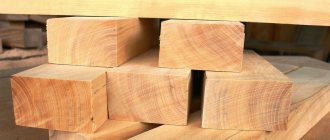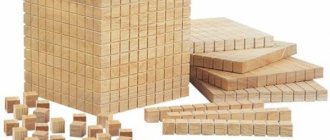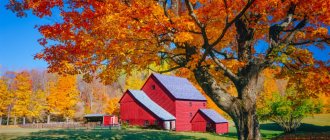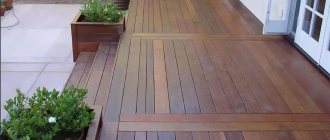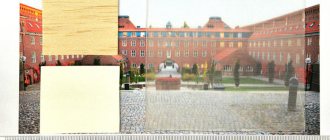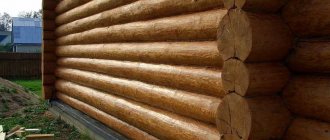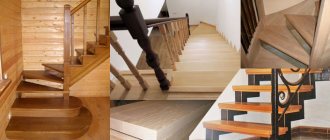There are many types of wood suitable for building fences, gazebos, various fences and even houses. Wooden material has a lot of advantages, but there is also one drawback - it is low resistance to biological agents and rot. Therefore, it is advisable to choose wood for construction that is least susceptible to rotting, especially for areas with a humid climate.
Causes of wood rotting
The main cause of wood rotting is high humidity in the air or the material itself. Damp wood is a natural habitat for fungi, mold and rot. Under their influence, the external characteristics of the material, its strength characteristics, etc. deteriorate. Wood can become infected with biological agents while still in the forest; they may not manifest themselves for a long time, but as soon as high humidity, warmth, and lack of fresh air are provided, they will begin to act.
Another cause of wood rot can be insects. They do not deteriorate the surface layers of the material, but penetrate into its depths. Many beetles feed on wood fibers, reducing its strength, but the most dangerous thing is that they can carry a fungal infection that begins to develop inside the wood. In this case, contamination of the material is detected too late, and it is impossible to restore the previous properties of the wood.
Wood species that are most resistant to rot
Valuable wood species are the least susceptible to rotting. They are expensive and not everyone is able to purchase them for construction. For example, oak is such a material. It resists adverse environmental influences. It is not spoiled by fungus, wind, sun, or water. When it comes into contact with water, on the contrary, it only becomes stronger and acquires a darker shade. Oak is difficult to process and it is difficult to give it a certain shape. It practically does not crack or warp. The older the oak tree itself, the better its wood.
A slightly less affordable, durable and rot-resistant wood is larch. This is a coniferous tree with a straight trunk. For several hundred years, the city of Venice has stood on Siberian larch, from which we can draw conclusions about its strength and other characteristics. It practically does not rot and is not affected by blue fungus. It is less susceptible to insects and fungi due to the characteristics of its resin, which plays an antiseptic role. Larch has an interesting texture, which after processing the material looks beautiful. The natural shade of this wood is dark brown.
The following coniferous species are more affordable and able to resist rotting:
- Pine. It belongs to soft species, it is easy to saw, plan, and process. This wood has a straight and even trunk. Pine does not crack much when it dries. It has a yellowish-white tint, a distinct texture and a large amount of resin, due to which it is protected from rotting. There is also ship pine; it is not afraid of moisture and is actively used in shipbuilding. It differs from ordinary pine by a taller and smoother trunk. And its resin content depends on the time of year and the age of the tree.
- Spruce. The tree has a smooth, straight, round trunk. It is more difficult to process due to the hardness of the existing knots, despite the fact that the wood itself is soft. Spruce has a looser structure and is warmer than pine and can crack when dried. This wood is rarely affected by blue stain. The color of the spruce is white, with a golden tint.
- Cedar. This wood is sometimes called cedar pine. It is a soft rock with a beautiful texture and is easy to work with. The heartwood of cedar has a pinkish tint, and its sapwood is white-yellow. In its density it is similar to pine and spruce. Cedar is resistant to rotting and cracking.
Larch
The strength and resistance of larch to rot allows the use of products made from it in the harshest conditions. If the labor-intensive processing technology has been followed, the wood is durable and reliable. The frames of European buildings, erected from powerful and heavy larch timber, can stand for hundreds of years without undergoing any changes. Parquet mosaic elements made from larch have a beautiful reddish tint and do not require painting or varnishing. The building supports that became the basis for Venetian buildings were also made from larch trunks.
Expert opinions
For construction, it is best to purchase softwood materials. They are more durable than deciduous trees. Their trunks have an even shape. In addition, they emit a pleasant aroma, and the substances contained in wood have bactericidal properties and have a beneficial effect on human well-being and health.
The most common coniferous species are spruce, pine and cedar; they are often used in the construction of log bathhouses, houses and other structures. But still, without additional protective work, they cannot last long.
The paradox of stained wood: why it does not rot in water and can last 500 years
Stained wood, as you know, costs several times more than regular wood. But what is so valuable in a tree trunk that has lain in water for 50, 100 or 500 years? And why does wood, when in water, not succumb to rotting processes, as happens to it on land?
Today it is customary to call oil black gold, but in the pre-industrial era this was the name given to bog oak - a valuable building material from which durable houses were built. Although even today, among professional woodworkers, bog oak wood is called black gold.
Stained wood is a tree (a whole trunk or some parts of a tree) that has lain in water for more than 40-50 years. This wood has special properties and is used to make exquisite figurines, boxes, interior items and even jewelry. But not all tree species that have lain in water can produce high-quality stained wood.
Traditionally, the most valuable stained wood species were stained oak and stained larch. The wood of these species has a high density, so heavy logs, if they fall into the water, sink to the bottom. This is very important, because if a tree floats on the surface of water, then the process of rotting inevitably begins. But if the trunk sinks to the bottom, in water, and often under a layer of silt in conditions of low oxygen content, specific processes begin to take place in the wood. Transformation and conservation of wood is a long process that takes at least 40-50 years, and even better 200-300 years, and the optimal conditions for it are stagnant waters of lakes or swamps. The tannins contained in the bark of trees interact with the salts contained in any fresh water, as a result of which the wood becomes very hard and durable.
But the main problem associated with the extraction of bog wood is the difficult process of lifting it from the bottom. Such trees are incredibly heavy, often buried under a thick layer of silt, and in most cases, scuba divers and special equipment are required to extract them.
But it is not enough to remove the stained tree trunk from the water; you need to dry it properly. The fact is that wood raised from the bottom of a reservoir needs to be dried slowly. Without a special slow drying procedure, it cracks, the fibers break, and such wood no longer has any value. Therefore, according to experts, real high-quality stained wood should dry for at least a year.
If in Europe valuable bog wood has long been raised from the bottom, then in our country there are significant reserves of this valuable building material. The largest reserves of bog oak are concentrated in the rivers of the European part of Russia. In addition to this, there are trunks of aspen, birch, pine and some other species. Well, Siberian rivers are rich in bog larch, which ended up at the bottom both during floods and as a result of timber rafting. The heavy larch instantly sank and sank to the bottom, and some river beds along which the timber was rafted were completely littered with tree trunks. There is also a lot of bog wood at the bottom of Lake Baikal. You can see how the Baikal bog wood rises in this video.
How to increase the service life of wooden material
To protect wooden material from negative weather conditions, insects, fungus, etc. you just need to carry out thorough treatment in a timely manner using special impregnations. Now there are a lot of antiseptic compounds. Safe, water-based products are produced for indoor areas. For wooden products located outdoors, more powerful impregnations are available. Oil and organic impregnations are suitable for this treatment.
When processing wooden log houses, special attention should be paid to the lower crowns that have contact with the ground and foundation. They are more exposed to negative influences, because The main enemy of wood is moisture, which constantly accompanies them. It is necessary to use antiseptic compounds for them that have antibacterial and at the same time moisture-resistant properties.
It is better to use complex products for processing wooden materials; they protect the wooden structure not only from biological contamination and rotting, but also from fire. Their compositions contain fire retardants, which improve the fire resistance of wood. And at the same time, many such complex products improve the appearance of wood, thanks to the ability to create a decorative coating on the surface that does not hide the natural beauty of the material.
Where to start protecting a wooden house from rot
Just purchasing the “right” material for construction is not enough. The points listed below must be taken into account.
Selecting a location
It is not advisable to place the house in a lowland, at the foot of a hill. Otherwise, the foundation will constantly get wet, and waterproofing will have to be laid in several rows so as not to constantly stop rotting. If there is no other option, high-quality drainage is required to drain storm and flood waters.
Foundation height
It is recommended to equip a monolithic foundation for a frame or timber cottage. The height above ground level is at least 30 cm. To guarantee the protection of the tree, it is better to lay the ground floor of brick and concrete. It can also be used as a basement, underground garage, or storage room.
Planting
Bushes and trees should not come into contact with the walls or roof of the house. Numerous bugs living in the crown should not be given an additional opportunity to move to the log house.
Minimum decorative elements
Carved platbands look beautiful on windows, porches, and front doors. But moisture collects in numerous protrusions, recesses, and depressions, provoking the development of mold, and then rot.
It is advisable to install visors over the windows, and all wooden surfaces that do not have protection should be treated with water-repellent compounds. Drainage and thoughtful ventilation will help speed up the evaporation process.
Time interval between construction and start of finishing
If the builders have just left the site, you cannot immediately start plastering, painting the walls, covering them with plasterboard or clapboard. At least six months are allocated for the final drying and shrinkage of the tree. If this period is not met, significant amounts of moisture will be “locked” inside the load-bearing structures. Very soon they will appear in the form of black spots of mold, and then rot.
Roof, hydro and thermal insulation
A mandatory element of the slopes is a full-fledged drainage system with gutters, funnels, and pipes to drain water away from the foundation. The roof itself should have a protrusion within 40-60 cm to protect the walls from direct sunlight.
The vapor barrier film is always placed at the beginning of the heat flow, where the temperatures are positive. The thermal insulation membrane must be located at the end of the heat flow. In this case, condensation will not accumulate in the supporting structures. Another condition is the sealing of the joints of timber or logs, the point where the pipe exits from the stove or heating boiler to the roof.
Adviсe
You can reduce the risk of rot on wood by properly harvesting it. It is best to prepare the forest in winter. It is during this period that the movement of juices in the wooden material stops and as a result the wood becomes drier, it contains less moisture and fewer cracks form on its surface. And most importantly, the forest must be absolutely healthy. Knowing the moisture level in wood is very important for builders. The smaller it is, the better. Due to high humidity, when drying, the wooden material greatly cracks and there is a higher risk of the formation of wood-staining and wood-destroying fungi on the surface.
Photo: Almost all coniferous trees suffer from blue stains. They are caused by various fungi, so after construction they should be immediately treated with antifungal drugs. If possible, a wooden structure should be assembled in cold weather - in winter, when biological agents are less active. But if they nevertheless appear on the surface of the wood during construction, they can be completely eliminated with special bleaching compounds.
Dyeing as a method of combating putrefactive processes
Paint is traditionally used for the following purposes:
- giving the product, in this case made of wood, an attractive appearance;
- protection from waterlogging or drying out, fight against rot.
But to solve the problems it is important to consider:
- Adhesion or penetration. The higher it is, the longer the paint layer will stay on the log or beam. If adhesion is low, cracks will appear in a maximum of a year and the protective properties will be lost.
- Covering power. It is determined by the quality and quantity of pigment. If the indicator is at the proper level, it is enough to apply the paint in one layer.
- Drying time. It determines when it will be possible to move on to the next stages of finishing.
- Elasticity. This criterion is especially important when carrying out outdoor work. If the paint is not flexible, it will crack when exposed to sunlight or moisture.
When choosing paint for anti-rot treatment, it is important to consider not only the previously listed factors, but also the composition. So, oil options are time-tested, but they take a long time to dry and smell bad. In all respects, alkyd modifications are a good alternative to oil modifications, and they are also characterized by increased elasticity.
Water-based ones cannot be used for street work. But indoors they dry out in a couple of hours, without leaving even a hint of smell. One of the varieties is acrylic. After drying, a durable film remains on the surface of the wood, which is not afraid of temperature changes.
Another option is emulsion. Coloring pigments are added to varnish or oil. The covering power is low, but there is good elasticity. At the same time, it dries for a long time and leaves behind a strong smell.
Reviews
Spruce was used to build their bathhouse. This is a warm conifer, with good data and price. But it contains a considerable amount of resin, which protects against insects and prevents the formation of fungi, but when heated it begins to flow. Therefore, the interior had to be finished with deciduous wood, linden. It tolerates temperature changes well, but high humidity causes fungi and mold to form on its surface very quickly. Therefore, the walls and ceilings had to be immediately treated with protective impregnations. The outside of the bathhouse stood for a year without any antiseptic treatment, but all its pine crowns were intact.
Igor Vishnevetsky, 28 years old (Kartaly).
You can build a building from almost any wood, the main thing is that it is healthy. But in order to prolong its life, it is necessary to take care of it and carry out high-quality treatment with protective compounds in a timely manner.
We hope that we were able to competently answer your questions: what kind of wood practically does not rot? And what can extend the life of wood?
Where can I buy the necessary products to protect wooden structures?
You can get professional advice on these antiseptic compounds from the honored worker in the field of wood protection from pests: Galina Nikolaevna Zelentsova by phone: +7 (905) 752-77-20.
If you have made a choice in favor of protective equipment of the Neomid, Pirilax, Prosept or other brands, then you can buy them at retail , pick up from the city of Balashikha - here: Contacts.
place a small wholesale order of effective wood protection products with delivery by calling; ;.
Call!
The relative resistance of wood to decay.
When wet from contact with the ground,
GOST antiseptics at manufacturer prices |
from precipitation or moisture condensation, the wood is susceptible to fungal rot. Different types of wood (types of trees) have different resistance to fungal infections. According to resistance to wood decay, GOST 20022.2-80 divides all species into resistant (in terms of heartwood, these include Siberian pine (cedar), larch, common pine, oak, ash), medium-resistant (spruce, fir, beech), low-resistant (elm, maple) and unstable (birch, linden, aspen, alder).
Classification of wood according to resistance to decay.
| Class | Wood type | |
| sapwood | core | |
| Persistent | Scots pine, ash | Siberian pine (cedar), larch, common pine, oak, ash |
| Medium resistant | Spruce, Siberian pine (cedar), larch, fir | Spruce, fir, beech |
| Low-resistant | Birch, beech, elm, hornbeam, oak, maple | Elm, maple |
| Unstable | Linden, alder, aspen | Birch, linden, aspen, alder |
Comparative resistance to decay of natural wood of various species under natural conditions.
| Durability class. | Breeds in descending order of natural resistance. | The multiplicity of the natural resistance of wood species compared to the resistance of linden sapwood. |
| 1 | Larch (core) Oak (core) Ash (core) Ash (sapwood) Pine (core) Pine (sapwood) | 9,1 5,2 4,9 4,6 4,4 4.0 |
| 2 | Fir (core) Spruce (core) Fir (sapwood) Beech (core) Spruce (sapwood) Larch (sapwood) | 3,8 3,6 3,4 3,3 3,2 3,1 |
| 3 | Beech (sapwood) Hornbeam (sapwood) Elm (heartwood) Oak (sapwood) Maple (sapwood) Birch (sapwood) | 2,5 2,4 2,3 2,2 2,1 2.0 |
| 4 | Birch (kernel) Alder (kernel) Aspen (kernel) Alder (sapwood) Aspen (sapwood) Linden (sapwood) | 1.8 1.5 1.2 1.1 1.1 1.0 |
Relative stability of round timber during storage.
Based on the resistance of wood species during storage to damage by insects, fungi and cracking, round timber is divided, according to GOST 9014.0-75, into the following classes:
| Resistance class | Resistance to | ||
| insect damage | fungal infection | cracking | |
| 1 - persistent | fir, beech, mushroom, maple, alder, aspen, poplar, sycamore | fir, oak, elm, maple, sycamore, ash | spruce, fir, pine, cedar, alder, aspen, linden, poplar |
| 2 - unstable | spruce, pine, larch, cedar, oak, elm, ash, birch | spruce, pine, larch, cedar, birch, beech, hornbeam, alder, aspen, poplar, linden | larch, beech, hornbeam, elm, sycamore, maple, oak, ash, birch |
The standard applies to round timber of coniferous and deciduous species.
Biological corrosion of wood.
Wood is a very durable and resistant construction material in mildly aggressive conditions and has been widely used for centuries. The tensile strength of wood in compression along the fibers is 40-80, in tension - 80-100 and in bending - 60-150 MPa. Wood resists shock and vibration loads well. Most types of wood have low density, low coefficient of linear expansion and low thermal conductivity. Building structures made of wood do not require expansion joints, which are mandatory in metal, concrete and other structures. Wood can be used independently and in combination with other materials will be easily processed.
The main disadvantages of wood are flammability, rotting and hygroscopicity, which cause changes in the size, shape and properties of wood, as well as anisotropy - heterogeneity of properties. The mechanical properties of wood deteriorate in the presence of defects (cracks, knots, etc.), with an increase in temperature above 100 ° C, and also when moistened. Uneven shrinkage of wood in different directions causes warping, accompanied by an increase in internal stresses and cracking.
Wooden structures can last for many tens and even hundreds of years. However, improper selection and inept use of wood shorten its service life. In unfavorable conditions, with moisture, lack of reliable ventilation and drying, wooden structures collapse within several years. This is not explained by the shortcomings of the wood, but by non-compliance with operating conditions and dampness.
Wooden structures at a certain temperature and humidity are subject to rotting as a result of their destruction by fungi, as well as beetles and other types of insects. At the same time, the mechanical properties and color of the wood change.
Damage to wood by insects is called wormhole. Depending on the depth of occurrence, a wormhole is distinguished as superficial, shallow and deep. A superficial wormhole penetrates to a depth of no more than 3 mm, a shallow wormhole penetrates into lumber up to 5 mm and into round timber up to 15 mm, and a deep wormhole penetrates into lumber to a depth of more than 5 mm and into round timber more than 15 mm. The size of the wormhole lesion is determined by the number of holes per 1 m2 of timber.
Wood-decaying fungi pose a great danger to wooden structures. Under the influence of fungi that have settled in the wood, its color first changes. With the further development of wood fungi, the structure of the wood changes and its gradual destruction occurs.
Depending on the method of obtaining organic substances for nutrition, fungi are divided into two types: parasites and saprophytes. Parasites include fungi that develop on living plants or, less commonly, animals. Saprophytes are fungi that grow only on dead wood and organic remains of plant and animal origin.
Mushrooms develop from spores - tiny formations that develop into hyphae, and then grow together to form cords, mycelium and a fruiting body. There are about 60 species of wood-decaying fungi.
Wood decaying fungi cause wood to rot. The nutrient medium for fungi is wood cellulose. Fungi secrete a special enzyme - cytase, which converts water-insoluble cellulose (C6H10O5)n into a soluble substance - glucose (C6H12O6), according to the reaction
(C6H10O5)n + m H2O ® n C6H12O6.
In the body of the fungus, glucose is oxidized by atmospheric oxygen, forming carbon dioxide and water.
С6Н12О6 + 6О2 ® 6СО2 + 6Н2О.
The greatest destruction in wood of all species is caused by house fungi. The process of complete destruction of wood under conditions favorable for fungi (humidity above 25%, air temperature 18-20°C) can occur in 1-1.5 years.
The degree of damage to wood by fungi depends on the type and degree of development of the fungus.
The aggressive impact on wooden structures of biological objects - wood-destroying fungi, insects - is called biological corrosion of wood.
Coniferous wood, which contains resin, has greater chemical resistance than hardwood. Coniferous woods are very resistant to dilute solutions of acetic, phosphoric, lactic, butyric and hydrofluoric acids. Wood can withstand prolonged exposure to HCl (up to 10%) and sulfuric acid (up to 5.0%) almost unchanged, while concentrated acids easily destroy it.
Wood is least resistant when exposed to oxygen-containing acids (HNO3, conc. H2SO4, H2C2O4), as well as conc. HCl. Aqueous solutions of caustic alkalis slowly destroy wood. Salts of iron, aluminum, and zinc have a destructive effect on it. Wood is resistant to solutions of ammonia, Ca(OH)2, Ba(OH)2 and solutions of neutral salts of any concentration.
The durability of wooden structures increases when various paints and varnishes are applied to their surface or when the wood is impregnated with antiseptics and synthetic resins.
Winter forest. Winter harvesting timber.
Tags: Protection of wood from rotting, Antiseptic treatment of wood.
On the topic: GROUND TESTING METHOD FOR RESISTANCE TO DECAY GOST 18610-82
Wood protection - a brief technological description of the protective agents used.

